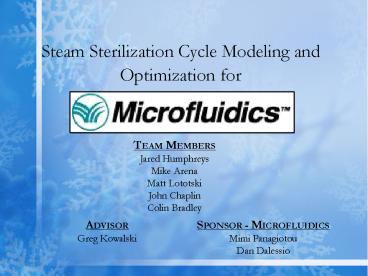Steam Sterilization Cycle Modeling and Optimization for - PowerPoint PPT Presentation
Title:
Steam Sterilization Cycle Modeling and Optimization for
Description:
Steam Sterilization Cycle Modeling and Optimization for TEAM MEMBERS Jared Humphreys Mike Arena Matt Lototski John Chaplin Colin Bradley ADVISOR Greg Kowalski – PowerPoint PPT presentation
Number of Views:139
Avg rating:3.0/5.0
Title: Steam Sterilization Cycle Modeling and Optimization for
1
Steam Sterilization Cycle Modeling and
Optimization for
- TEAM MEMBERS
- Jared Humphreys
- Mike Arena
- Matt Lototski
- John Chaplin
- Colin Bradley
ADVISOR Greg Kowalski
SPONSOR - MICROFLUIDICS Mimi Panagiotou Dan
Dalessio
2
Background
- ? Manufacture machines called Microfluidizers
- ? These machines force product through fixed
geometry micro-channels using intense pressure - ? Product goes in as random large particles and
exits as uniformly sized nanoparticles
3
Background
- ? Used in a growing number of pharmaceutical,
personal care, biotechnology, food and chemical
applications - ? System must be sterilized between each
processing session to ensure purity of product - ? Sterilization cycle is multi-staged and time
consuming - ? Wetted surface must be exposed to steam at
121C for at least 20 minutes per ASME BPE-a-2004
requirements
4
Competitive Technology
- High Shear Dispersers
- Pulverizing Mills
- Coaxial Mixers
- Planetary Ball Mill
- Not capable of achieving uniform nano-level
particles
5
Project Goals
FAILING SEAL WITHIN INTENSIFIER PUMPS
- To verify that all sections of the system which
come in contact with the product are heated to
121C or higher for at least 20 minutes during
the steam sterilization cycle - Find a solution to stop the intensifier pump seal
failure
Failing Seal
Piston
Product Chamber
6
Operation Sequences
- 1. Prime the machine
- Use WFI, USP Purified Water, Product or other
process compatible fluid - 2. Process Product
- 3. Clean in Place
- 4. Steam in Place
- 5. Cool Down
7
Steam in Place Process
- ? Steam in Place 3 Stages
- ? Heat product wetted piping and outside of
chambers first - ? Saturated steam from boiler at 138 C and 35
psig is passed through the system - ? Temperature and pressure are monitored at the
system inlet and outlet
8
Intensifier Pump Process
Step 1
Seal
Check Valve 1
Piston
Step 2
Check Valve 2
To Chambers
9
Seal Failure
- Seal failure method thermal degradation
- Seal material TIVAR H.O.T.
- Maximum seal operating temperature 135C
- Excessive temperature exposure or thermal cycling
causes the seal to crack and become softer
10
Deliverables
- ? Computer simulation of steam in using
computational fluid dynamics software (Fluent) - ? Analysis of simulation to determine that
current process complies with ASME sterilization
requirements - ? Recommendations of changes to current process
to eliminate seal failure
11
Solidworks Model
- ? Extremely complex
- ? Incompatible with Fluent analysis as-is
- ? Many components needed to be remodeled with
interior flow path defined (heat exchangers,
pumps, valves)
12
Area of Concern
Temperature and Pressure Sensors
- Focus area of current system successfully modeled
in Solidworks - File imported to Gambit for 3D meshing and
subsequent Fluent Analysis - Determined temperature around the seals to aid
design solutions
Intensifier Pumps
Chambers
13
Pressure Outlet Calculations
P1 inlet pressure P2 outlet pressure µ
viscosity V velocity D Diameter L length
of chambers
P1-P2 (64µVL)/(2D2) P1-0 (64)(0.000013
Ns/m2)(7.4 m/s)(.3 m)/(2)(0.000078m)2 P1
151,794 Pa
P1V1P2V2 (35psig)(1.1in2)P2(13.81in2) P2
2.95 psi Draw Pressure
14
CFD Analysis
Saturated Steam T1 411 K (138 C) P1 241300 Pa
(35 psig)
Pipe Sections 316L Stainless Steel
Seal Location (Inside Pump)
Tamb 298.1 K h 6 w/m2-K
P3 221310 Pa
P4 221310 Pa
P2 151000 Pa
15
GAMBIT Mesh
16
Static Pressure (Pa)
P1 241300 Pa
P3 221310 Pa
P4 221310 Pa
P2 151000 Pa
17
Static Temperature (K)
Seal Temperatures 408 K (135 C)
18
Velocity (m/s)
19
Reynolds Number
20
Thermal Verification
- mass flow rate m ?VA
- m (.546 kg/m³)(300 m/s)(.000792 m²)
- m .192 kg/s
- Heat Loss q mCpTin - Tout
- hAsTave - T8
- q (.129 kg/s)(2.0133 Ws/kgK)(408.1 - 407.9 K)
.026 Watts - q (6 W/m²)(.00374 m²)(407.95 - 298.1 K) .024
Watts
21
Proposed Solution
- By decreasing inlet temperature 5, seal
temperatures are well below limits (130 C max) - Transient analysis shows inlet temperature
adjustment does not significantly affect warm-up
time - Does not require any modification to current
system design
22
Static Temperature (K)
Decreased Inlet Temp 406 K (133C)
Seal Temperatures 403 K (130C)
23
Future Work
- Remodel pump chambers in GAMBIT to enable
analysis with piston motion simulated - Model remaining steam phases to ensure reduced
steam temperature can be used throughout entire
sterilization process
24
Questions?































